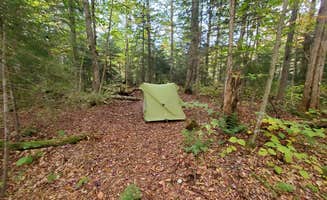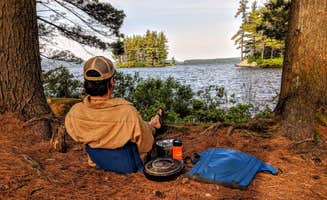Dispersed camping near Bloomingdale, New York offers primitive wilderness experiences in the northern Adirondack region. Most sites are situated between 1,500-2,000 feet elevation, where summer temperatures typically range from 45-80°F. Winter access becomes limited from November through April due to snow accumulation and seasonal road closures, with some access routes becoming impassable without specialized vehicles.
What to do
Backcountry fishing opportunities: At Crane Pond Dispersed Site, the fishing is exceptional directly from camp. "There is a stone cliff near it that goes down about 12(?) feet and is great for fishing or jumping off of. There is also a stone area right by the water if you want to fish," notes visitor Nicole T.
Island camping: For a more unique experience, consider the backcountry sites at Cranberry Lake. "We spent 3 nights backcountry camping on Catamount Island in Cranberry Lake and absolutely loved it! The sunsets from the island were truly incredible," reports Shari G., who appreciated the included amenities despite the remote location.
Hiking access: Several dispersed sites provide direct trail connections. The Ward Brook Campsite serves as an access point for mountain exploration. As Alex R. describes, it's a "Great campsite at the bottom of Seymour mountain" with practical amenities unusual for backcountry sites.
What campers like
Complete digital detox: Polliwog Lake on Floodwood Road offers genuine disconnection for those seeking to escape connectivity. Visitor Debbie T. simply states the appeal: "Camped here for a few days, no cell, no internet."
Island seclusion: The backcountry islands at Cranberry Lake Backcountry Sites provide exceptional privacy. "Each site has a picnic table and fire ring. Ours had an extensive pile of dry wood, too. There is a decent privy tucked back in the woods," notes Shari G., highlighting the surprising amenities despite the remote location.
Uncrowded experience: The dispersed nature of these sites ensures peaceful camping. Kristal Ann F. confirms this at Cranberry Lake, noting the "sites not crowded together" and the "amazing lake for kayaking and boating."
What you should know
Seasonal considerations: Most dispersed sites have no winter maintenance. From November through April, snow accumulation makes many access roads impassable without specialized vehicles. By late spring, mud season creates challenging driving conditions on unpaved access routes.
Water considerations: Bring filtration equipment for all camping areas. "You will either need to bring your own potable water or filter from the lake, so don't forget your water filter," advises a Cranberry Lake camper. Most sites require either carrying in water or filtering from nearby water sources.
Vehicle requirements: Access to Horseshoe Lake and similar sites requires appropriate vehicles. "Road is rough but easily doable if you take it slow," notes Rebecca B., who also mentions practical considerations for technology users: "As it's a forest, the sites are pretty shaded, so solar and Starlink may present challenges."
Tips for camping with families
Swimming access: Select sites with safe water entry points for children. At Little Green Pond, "Sites are on the Pond. Pond has a small beach to swim. Tree covered sites," according to Lo M., making it suitable for families with children who want water activities.
Insect preparation: The Adirondack region has significant insect activity from May through September. For hiking trails, a Cranberry Lake visitor advises, "The mosquitoes weren't bad at the campsite itself or while kayaking, they are terrible on the trails this time of year; so bring your bug spray, or better yet, bug shirts!"
Supply planning: Limited nearby services require advance preparation. The closest general stores often have restricted hours and limited inventory. "The Village of Cranberry Lake has some supplies, but not much except the very basics at the general store. You'll need to head to Star Lake or Tupper Lake for anything of significance," notes a visitor.
Tips from RVers
Access limitations: Most dispersed camping areas near Bloomingdale have significant RV restrictions. Crane Pond specifically is "NOT fit for an RV in any capacity," according to Nicole T., who emphasizes that even with 4WD vehicles, the road presents challenges as "your vehicle isn't lifted you may come out with a ding or two from rocks and other things jutting out of the ground."
Parking arrangements: For larger vehicles, consider parking at designated lots and walking to your site. Several areas like Ward Brook Campsite require hiking in, making them unsuitable for direct RV access but offering a base camp possibility with advance planning.
Solar limitations: The dense forest canopy impacts power generation capabilities. Rebecca B. notes at Horseshoe Lake that "the sites are pretty shaded, so solar and Starlink may present challenges," requiring alternative power solutions for longer stays.



